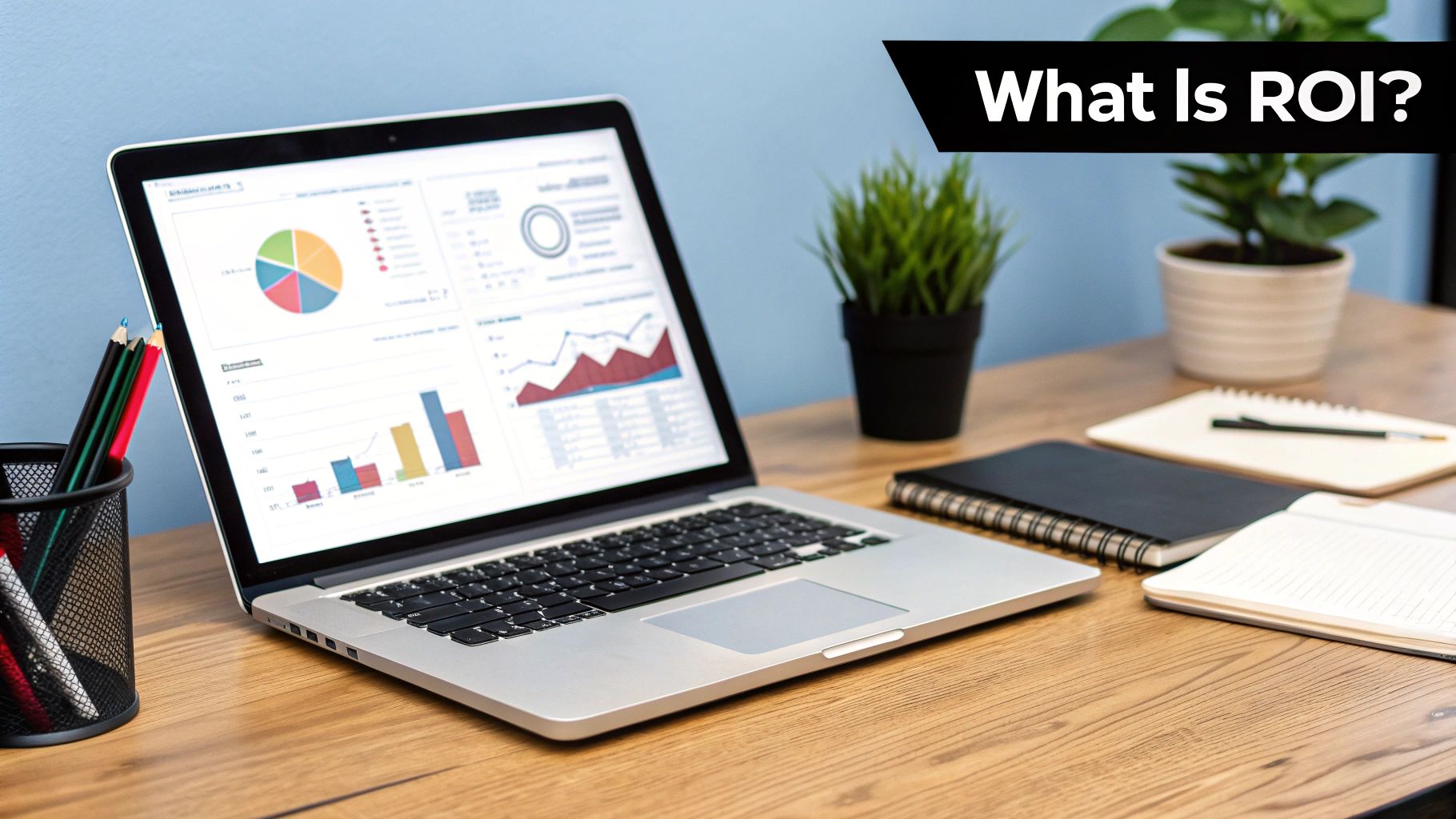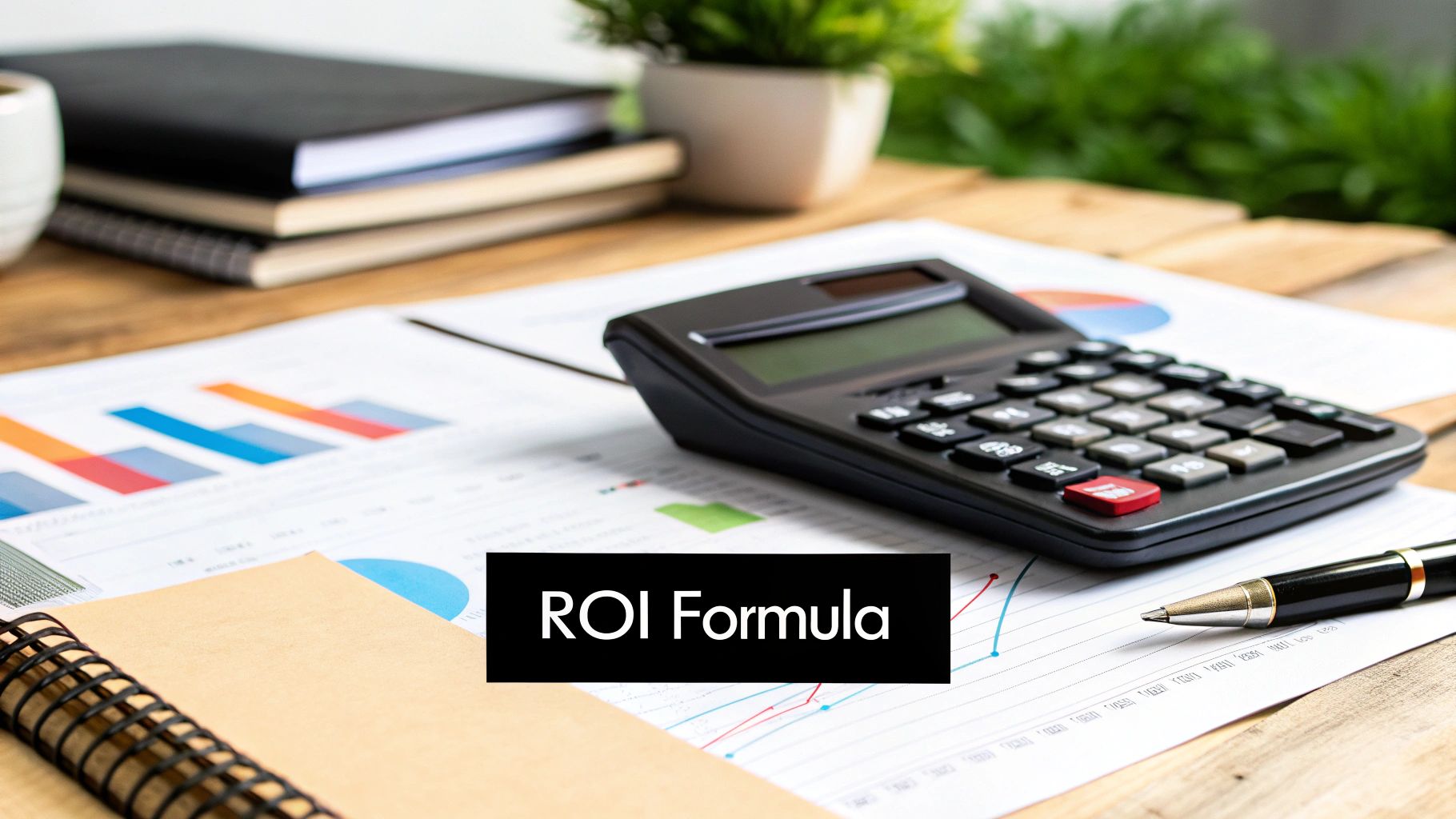Figuring out your Return on Investment, or ROI, doesn't have to be complicated. At its core, you just divide the net profit from an investment by its total cost, then multiply that by 100. This gives you a simple percentage that cuts right to the chase.
The formula looks like this: (Net Profit / Cost of Investment) x 100%.
In plain English, it tells you exactly how much bang you got for your buck.

Before you start plugging numbers into a calculator, it’s worth taking a moment to appreciate what ROI actually shows you. It’s more than just a number; it’s a story about your business decisions. ROI measures the financial gain or loss you get from the money you've put into a project, a marketing campaign, or a new piece of equipment.
Let's imagine a local bakery. They decide to spend $5,000 on a shiny new, high-efficiency oven. Over the next year, that oven allows them to bake more bread in less time, directly contributing to an extra $7,000 in profit. The ROI calculation is what proves whether this was a smart move.
The simplest way to calculate ROI is by comparing the net gain from an investment to what it originally cost you. The most common formula is ROI = (Final Value – Initial Investment) / Initial Investment × 100%. For example, if you put $1,000 into something and it grows to $1,200, your net gain is $200. That's a 20% ROI.
Let's apply this back to our bakery's new oven:
Using the formula ($7,000 / $5,000) x 100, the bakery gets a 140% ROI. That number immediately tells the owner that buying the oven was a fantastic financial decision.
A simple percentage makes it incredibly easy to compare different business moves. An ROI of 140% from a new oven is clearly a better use of cash than a marketing campaign that only brought in a 15% ROI.
To make it even clearer, here’s a quick breakdown of the formula's components.
This table unpacks each part of the ROI calculation so you know exactly what you're working with.
Once you get the hang of this basic calculation, you can apply it to just about anything.
Getting a solid grasp of this foundational concept is the key to making smarter financial choices. Whether you're weighing the cost of an ad campaign, hiring a new consultant, or investing in software like an AI receptionist, knowing how to calculate ROI gives you the clarity you need to grow your business effectively.
For a deeper dive into how this applies to professional services, you might find our guide on maximizing ROI in consulting projects helpful.
If you want a truly accurate ROI calculation, you have to get the numbers right from the very beginning. This isn't about guesswork; it's about painting a complete financial picture of every dollar that goes out and every dollar that comes in. At the end of the day, your final ROI figure is only as good as the data you feed it.
I've seen it time and time again: the biggest mistake people make is overlooking the hidden costs that quietly add up. To really nail your ROI, you need to understand every single investment cost. For a deeper dive, learning how to calculate cost per acquisition can give you a much clearer view of your spending.
Your total investment goes way beyond the sticker price of a new tool or what you spend on an ad campaign. It’s the grand total of every related expense, both the obvious and the not-so-obvious.
Let's imagine a small business bringing in new project management software:
These "soft costs" are so easy to miss, but they are absolutely essential for an honest assessment. When you add it all up, the real investment isn't $1,200—it's actually $2,500.
Just like costs can be hidden, your returns aren't always about a sudden flood of new sales. Your gains can show up as increased revenue, sure, but they can also come from saving money or just making your team more efficient. You have to think about how a new investment adds value across your entire operation.

Let’s stick with our project management software example. The return might look something like this:
So, the total annual return comes out to $22,200. For any service-based business, like an auto repair shop, these kinds of efficiency gains are a direct line to serious growth. In fact, there are plenty of other ways to maximize revenue in your auto repair shop by making similar improvements.

Marketing spend is often a major line item on the budget, but its true impact can feel frustratingly abstract. To really understand what's working, you have to move beyond vanity metrics like clicks and likes and connect your marketing efforts to actual financial outcomes.
A common pitfall I see is stopping at lead generation. Sure, counting new leads is a start, but it doesn't tell you if those leads actually turned into paying customers. The real goal is to follow the money from the initial ad click all the way to the final sale.
Let's walk through a practical scenario. Imagine a B2B company that spends $5,000 on a targeted LinkedIn ad campaign. But that's not their only cost—they also paid a designer $1,000 for the ad creative. That brings their total investment to a neat $6,000.
Over the next month, that campaign generates 30 qualified leads. Using their CRM, they track these specific leads and find that five of them converted into new clients, bringing in a total of $35,000 in new contract revenue.
To figure out their marketing ROI, they use a straightforward formula: (Revenue - Investment) / Investment x 100. This calculation reveals exactly how effectively their marketing dollars generated sales. If you want to get more granular, there are some great resources on how to measure marketing ROI with tailored insights.
In this B2B world, many experts aim for a 5:1 ratio of revenue-to-spend. It's a solid benchmark that tells you your marketing investment is paying off handsomely.
By connecting specific campaigns to real revenue, you transform marketing from a cost center into a predictable growth engine. You can confidently double down on what works and cut what doesn’t.
This same logic applies to all your marketing channels, not just digital ones. Understanding the financial return is just as critical for physical initiatives. For instance, you can see how these same principles work in a different setting by checking out our guide on measuring event ROI.
At the end of the day, calculating the ROI of your marketing campaigns is the key to strategic, sustainable growth.
A single ROI percentage is a great starting point, but let's be honest—it rarely tells you the whole story. If you want to make genuinely strategic business decisions, you have to dig a little deeper. The basic formula is fantastic for its simplicity, but it has one major blind spot: it completely ignores the element of time.
Think about it. A 30% return delivered in just six months is worlds away from the same 30% return trickling in over three long years. This is where a couple of more advanced concepts can add some much-needed context, helping you compare different opportunities on a truly level playing field.
To factor in time, we can turn to Annualized ROI. This calculation simply standardizes your returns into a yearly figure, making it instantly clear which investment is pulling its weight more effectively over time. It answers the critical question, "If this investment kept up its current pace, what would my return look like after one full year?"
This adjustment is vital. It keeps you from mistakenly thinking a slow, multi-year project is just as successful as a fast, high-impact initiative that happens to have the same final ROI number.
Now for the tricky part: how do you measure the benefits that don't come with a neat price tag? What's the ROI of a surge in positive brand sentiment or a noticeable boost in team morale? We call these intangible benefits, and while they're harder to pin down, their value is immense.
The trick is to create a framework that assigns an estimated financial value to these qualitative gains. It’s more straightforward than it sounds.
By translating these abstract wins into concrete numbers, you build a much more holistic and insightful picture of an investment's true worth. This is how ROI evolves from a simple accounting metric into a powerful tool for strategic decision-making.

Trying to justify the spend on new software or AI tools can feel like a tough sell. It's not like buying a new machine that spits out a tangible product. The returns from technology are often less obvious—they show up as efficiency gains, surprise cost savings, and smarter decision-making.
The trick is to translate all those soft benefits into hard numbers.
Take an AI-powered customer service tool like My AI Front Desk. It does more than just help close deals. Its real value often lies in reducing the workload on your human staff, a benefit you can measure directly in saved salary hours.
To build a business case that actually works, you have to look beyond the immediate bump in sales. With the rise of AI and complex operational data, the calculation has gotten a lot more interesting. A solid ROI analysis now needs to account for direct revenue, indirect cost savings, and efficiency boosts.
Think of it this way for a new tech tool:
By putting a dollar value on each of these areas, you paint a complete picture of the technology’s total financial impact. It makes your ROI calculation far more accurate and, frankly, a lot more convincing.
This multi-faceted approach is the only way to capture the full value of what you're paying for. If you want to see a great example of how technology can deliver these kinds of measurable returns, check out these Virtual Reality Training Solutions That Drive Results.
When you add up all these distinct gains, you get the total "Return" figure you need for that classic ROI formula.
Of course, once you start digging into ROI, you’ll run into a few common questions. It’s one thing to know the formula, but it's another to apply it in the real world. Let's tackle some of the hurdles I see businesses face all the time.
This is the million-dollar question, and the honest answer is: it depends. There's no universal magic number that works for everyone. A "good" ROI is all about context.
For instance, putting money into a low-risk asset might make a 10% annual return look fantastic. But if you're talking about a B2B marketing campaign, you'd likely be aiming for something closer to a 500% return (a 5:1 ratio) to call it a real win.
The best way to figure out your target is to look at your own history. Benchmark against past performance, what your competitors are doing, and what other opportunities you could be investing in instead.
What about investments that won't pay off for months, or even years? In these cases, you'll want to use a forecasted ROI. This isn't just a guess; it's about building a realistic financial model to project what you expect to see down the line.
Your projections should be grounded in solid research:
Just remember to label any forecast as a projection. You'll want to revisit and update your numbers as you start getting actual performance data.
One of the biggest blind spots of the basic ROI formula is that it ignores the time value of money. A 20% return earned in one year is way more valuable than that same 20% spread out over five years.
This is where a metric like Annualized ROI can give you a clearer picture. It’s also worth remembering that standard ROI can't measure intangible benefits like brand loyalty or customer satisfaction. That’s why it should be just one of several metrics you use to make big decisions, not the only one.
Ready to see the ROI of automating your front desk? With My AI Front Desk, businesses save time, capture more leads, and see a measurable return through powerful AI receptionists and outbound dialers. Discover how it works and start your free trial today!
Start your free trial for My AI Front Desk today, it takes minutes to setup!








